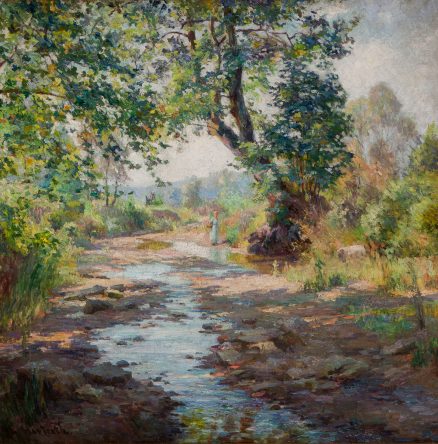- Categories
- Landscapes
- Women artists
- Zoom in on Artwork
- Print Page
- Email Page to Friend
Lucie Hartrath’s The Creek presents tranquil rural scenery glimpsed from beneath the shelter of overhanging foliage. A shallow meandering stream leads from the shadowed foreground into the light-filled distance, toward the figure of a woman at the center of the perfectly square composition. With her pale-blue dress and straw hat, she blends almost to invisibility in the bright landscape, while her apparent solitude and the basket on her arm underscore an impression of benignant nature and simple country life.
The Creek exemplifies Lucie Hartrath’s interpretation of the setting with which she became closely associated, rustic Brown County in central Indiana. Beginning in 1906 the region was “discovered” by Indiana and Chicago painters in pursuit of local subjects that fulfilled an ideal of landscape nurtured in rural France and Holland. Brown County’s hilly wooded terrain, winding lanes, and sleepy hamlets soon attracted numerous artists who found its atmosphere in particular reminiscent of that of northern France. Hartrath visited Brown County repeatedly, painting the scenery saturated in summer greens or in bright autumnal tints with a modified impressionist style that combined visibly broken brushwork with conventional representation and spatial recession. The consumers of her idyllic landscapes were urbanites from Chicago, Indianapolis, and other cities. Like their touristic excursions to rural locales already popularized as artists’ haunts, their admiration for paintings such as The Creek expressed nostalgia for a preindustrial America. Although Hartrath probably completed the painting in the months that witnessed the reluctant entry of the U.S. into World War I, her restful image suggests a world innocent of conflict or tragedy.
The Creek was among twenty-four works in Hartrath’s solo exhibition at the Carson Pirie Scott and Company department store in May 1917, according to a review in the Fine Arts Journal in which the painting was reproduced with its current title. The following February, the Art Institute’s annual exhibition of works by Chicago-area artists included Hartrath’s The Creek in Summer, possibly also this work. In a biographical questionnaire completed for the Illinois Academy of Fine Arts in 1929, the artist listed The Creek, Late Summer—perhaps yet another title for this painting—as one of her most important works. Whether by choice or happenstance, The Creek remained in Hartrath’s possession until 1936, when it won a purchase prize in the summer Hoosier Salon, held at Lake Wawasee, Indiana.
Wendy Greenhouse, PhD
